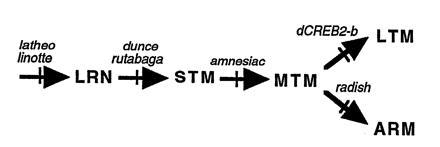Figure 4.

Information processing during memory formation after Pavlovian olfactory learning. Newly acquired information (LRN) first is processed sequentially through short-term memory (STM) and middle-term memory (MTM) phases. Then information processing branches into two functionally independent phases: anesthesia-resistant memory (ARM) and long-term memory (LTM). Massed training induces LRN, STM, MTM, and ARM, whereas spaced training induces LTM along with similar amounts of LRN, STM, MTM, and ARM. Different single-gene mutants (latheo, linotte, dunce, rutabaga, amnesiac, and radish) disrupt this process at different steps. Notably, the radish mutation disrupts ARM without affecting LTM, and the protein synthesis inhibitor cycloheximide (CXM) or inducible dominant-negative CREB transgenes (dCreb2-b) disrupt LTM without affecting any other aspect of learning or memory. Thus, ARM and LTM appear to be functionally independent, parallel memory phases. (Data from ref. 37.)
